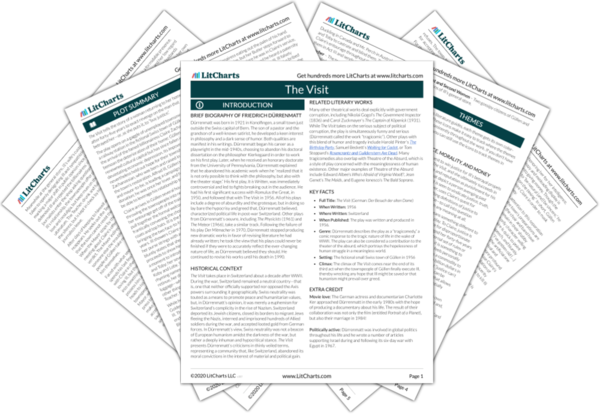Welcome to the LitCharts study guide on Friedrich Dürrenmatt's The Visit. Created by the original team behind SparkNotes, LitCharts are the world's best literature guides.
The Visit: Introduction
A concise biography of Friedrich Dürrenmatt plus historical and literary context for The Visit.
The Visit: Plot Summary
A quick-reference summary: The Visit on a single page.
The Visit: Detailed Summary & Analysis
In-depth summary and analysis of every act of The Visit. Visual theme-tracking, too.
The Visit: Themes
Explanations, analysis, and visualizations of The Visit's themes.
The Visit: Quotes
The Visit's important quotes, sortable by theme, character, or act.
The Visit: Characters
Description, analysis, and timelines for The Visit's characters.
The Visit: Symbols
Explanations of The Visit's symbols, and tracking of where they appear.
The Visit: Theme Wheel
An interactive data visualization of The Visit's plot and themes.
Brief Biography of Friedrich Dürrenmatt
Dürrenmatt was born in 1921 in Konolfingen, a small town just outside the Swiss capital of Bern. The son of a pastor and the grandson of a well-known satirist, he developed a keen interest in philosophy and a dark sense of humor. Both qualities are manifest in his writings. Dürrenmatt began his career as a playwright in the mid-1940s, choosing to abandon his doctoral dissertation on the philosopher Kierkegaard in order to work on his first play. Later, when he received an honorary doctorate from the University of Pennsylvania, Dürrenmatt explained that he abandoned his academic work when he “realized that it is not only possible to think with the philosophy, but also with the theater stage.” His first play, It is Written, was immediately controversial and led to fights breaking out in the audience. He had his first significant success with Romulus the Great, in 1950, and followed that with The Visit in 1956. All of his plays include a degree of absurdity and the grotesque, but in doing so lay bare the hypocrisy and greed that, Dürrenmatt believed, characterized political life in post-war Switzerland. Other plays from Dürrenmatt’s oeuvre, including The Physicists (1961) and The Meteor (1966), take a similar track. Following the failure of his play Der Mitmacher in 1970, Dürrenmatt stopped producing new dramatic works in favor of revising literature he had already written; he took the view that his plays could never be finished if they were to accurately reflect the ever-changing nature of life, as Dürrenmatt believed they should. He continued to revise his works until his death in 1990.
Get the entire The Visit LitChart as a printable PDF.

Historical Context of The Visit
The Visit takes place in Switzerland about a decade after WWII. During the war, Switzerland remained a neutral country—that is, one that neither officially supported nor opposed the Axis powers surrounding it geographically. Swiss neutrality was touted as a means to promote peace and humanitarian values, but, in Dürrenmatt’s opinion, it was merely a euphemism for Switzerland’s complicity in the rise of Nazism. Switzerland deported its Jewish citizens, closed its borders to migrant Jews fleeing the Nazis, interned and imprisoned hundreds of Allied soldiers during the war, and accepted looted gold from German forces. In Dürrenmatt’s view, Swiss neutrality was not a beacon of European humanism amidst the darkness of the war, but rather a deeply inhuman and hypocritical stance. The Visit presents Dürrenmatt’s criticisms in thinly veiled terms, representing a community that, like Switzerland, abandoned its moral convictions in the interest of material and political gain.
Other Books Related to The Visit
Many other theatrical works deal explicitly with government corruption, including Nikolai Gogol’s The Government Inspector (1836) and Carol Zuckmayer’s The Captain of Köpenick (1931). While The Visit takes on the serious subject of political corruption, the play is simultaneously funny and serious (Dürrenmatt called the work “tragicomic”). Other plays with this blend of humor and tragedy include Harold Pinter’s The Birthday Party, Samuel Beckett’s Waiting for Godot, or Tom Stoppard’s Rosencrantz and Guildenstern Are Dead. Many tragicomedies also overlap with Theatre of the Absurd, which is a style of play concerned with the meaninglessness of human existence. Other major examples of Theatre of the Absurd include Edward Albee’s Who’s Afraid of Virginia Woolf?, Jean Genet’s The Maids, and Eugene Ionesco’s The Bald Soprano.
Key Facts about The Visit
- Full Title: The Visit (German: Der Besuch der alten Dame)
- When Written: 1956
- Where Written: Switzerland
- When Published: The play was written and produced in 1956.
- Genre: Dürrenmatt describes the play as a “tragicomedy,” a comic response to the tragic nature of life in the wake of WWII. The play can also be considered a contribution to the theater of the absurd, which portrays the hopelessness of human struggle in a meaningless world.
- Setting: The fictional small Swiss town of Güllen in 1956
- Climax: The climax of The Visit comes near the end of its third act when the townspeople of Güllen finally execute Ill, thereby wrecking any hope that Ill might be saved or that humanism might prevail over greed.
Extra Credit for The Visit
Movie love: The German actress and documentarian Charlotte Ker approached Dürrenmatt in the early 1980s with the hope of producing a documentary about his life. The result of their collaboration was not only the film (entitled Portrait of a Planet), but also their marriage in 1984!
Politically active: Dürrenmatt was involved in global politics throughout his life and he wrote a number of articles supporting Israel during and following its six-day war with Egypt in 1967.












